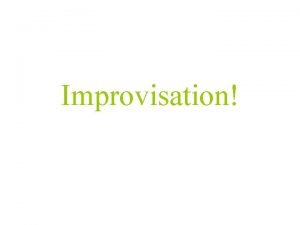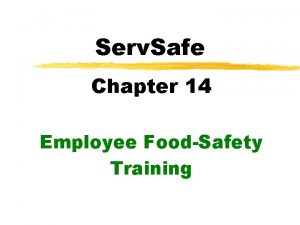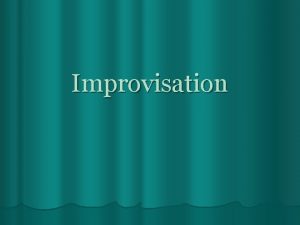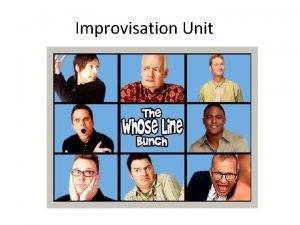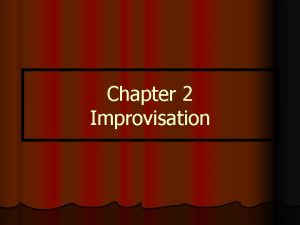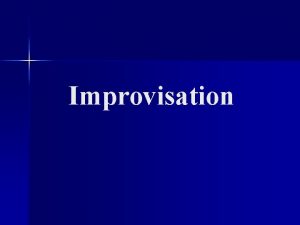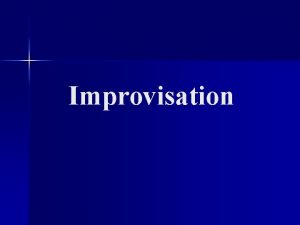Improvisation Improvisation 1 Elements of Successful Improvisation 2











- Slides: 11

Improvisation

Improvisation 1. Elements of Successful Improvisation 2. General Rule of Improvisation (Do’s and Don’ts) 3. Forms of Improvisation

The Elements of Successful Improvisation A good improvisation is a form of drama. The fact that the scene is being “written” as it is performed doesn’t alter the requirements of drama. There are certain elements which are essential for an successful scene, including improvisational scenes.

The Elements of Successful Improvisation 1. Characters • • Specific “people” with recognizable characteristics Motivated/doing for a reason 2. Relationship • • A relationship must exist between the characters in stage There must be a relationship between the players and their environment

The Elements of Successful Improvisation 3. Setting/Environment • Location affects your actions and style • Interact with setting (props, furniture, etc. ) 4. The Event (conflict and action) • Crucial to every scene – the situation that makes this day different from all the rest • Something must be happening

The Elements of Successful Improvisation 5. Dialogue and Humor • Allow characterization/conflict to motivate the dialogue • Don’t play to the punch line – sometimes being smart is better than being funny • Don’t force laughs – be natural

A Few General Rules: The Do’s and Don’ts of Improv 1. Know the structure thoroughly • • • Rules Rehearse Make connections – audiences like “smart” performers 2. Don’t show off • • • It’s a team effort – don’t upstage The best way for an improviser to look good is by making her/his fellow players look good Respect choices made by others

A Few General Rules: The Do’s and Don’ts of Improv 3. Know your partners • Sense where they are going and go with it • Help out when others are stuck 4. Listen to other people on stage • Yes and… accept and build • Be a team player • Respect the choices made by others

A Few General Rules: The Do’s and Don’ts of Improv 5. Don’t let the scene run too long • Get out while you are ahead 6. Don’t deny • There are no bad choices. There are no mistakes. • Make assumptions don’t ask questions • Accept your partners’ offers

A Few General Rules: The Do’s and Don’ts of Improv 7. Have fun and don’t worry! • Commit to the scene and your character 100% • Stay in the moment • Take the scene seriously • Keep it simple – less is more • Show, Don’t tell • Start in the middle • Keep an open mind

Forms of Improv 1. Short Form: Includes performance worthy games, or short artistic forms (scenes). 2. Long Form: A style of improvisation that takes a suggestion from the audience and weaves it into a stream of consciousness performance. Truth is, there are many different formats for long form. Some formats are like mini-plays. Other formats are like a series of consecutive short scenes or games.
 Elements of improvisation
Elements of improvisation Improvisation tips
Improvisation tips Jazz improvisation with lstm
Jazz improvisation with lstm What is improvisation
What is improvisation Duchamp fountain
Duchamp fountain A form of vocal improvisation on nonsense syllables.
A form of vocal improvisation on nonsense syllables. Factors contributing to the success of a tourist attraction
Factors contributing to the success of a tourist attraction What are job aids servsafe
What are job aids servsafe A strong desire to be successful
A strong desire to be successful Successful club series
Successful club series Unit 6 managing a successful business project
Unit 6 managing a successful business project Toastmasters successful club series
Toastmasters successful club series



